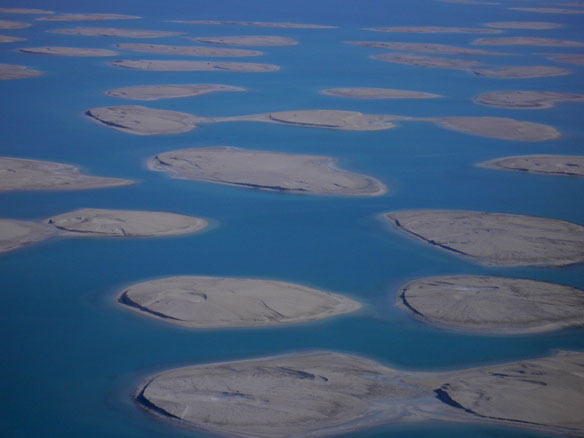
Artificial islands, Dubai, United Arab Emirates. Photograph: © SAF — Coastal Care.
“Sand is the second most consumed natural resource, after water. The construction-building industry is by far the largest consumer of this finite resource. The traditional building of one average-sized house requires 200 tons of sand; a hospital requires 3,000 tons of sand; each kilometer of highway built requires 30,000 tons of sand… A nuclear plant, a staggering 12 million tons of sand…” Captions by: “Sand Wars” Multi Award-Winning Filmmaker Denis Delestrac (©-2013).
Excerpts;
Dubai is growing again, and again it’s building into the sea…
Read Full Article, CNN (05-18-2017)
Dubai’s Staggering Growth, NASA
To expand the possibilities for beachfront development, Dubai undertook a massive and controversial engineering project to create hundreds of artificial islands along its Persian Gulf coastline. Built from sand dredged from the sea floor, the islands are shaped in recognizable forms such as palm trees. The construction of the various islands off the coast of Dubai has resulted in changes in area wildlife, coastal erosion and alongshore sediment transport, and wave patterns.
A Picture of Earth Through Time
In the mid-1980s, when the Timelapse images begin, Dubai was a small desert city of about 300,000 people, overshadowed by nearby Abu Dhabi, the capital of the United Arab Emirates. What growth Dubai had experienced was mostly recent; in the 1950s it was little more than a village, with pearl diving its chief industry. Today, Dubai’s population exceeds 2.1 million, and the metropolis has asserted itself as the financial center of the Middle East. Explore a global timelapse of our planet, constructed from Landsat satellite imagery. Witness two palm trees and a map of the world appear as islands off the coast of Dubai.
Land reclamation has harmed marine life: Survey, The Peninsula Quatar (03-05-2017)
Survey shows that land reclamation has adverse effects on coral reefs and fish quantity has decreased in the last five years in the coastal areas of Doha, Quatar…
What Happens to a Coral Reef When an Island is Built on Top? the Washington Post (07-11-2015)
Seven such coral reefs are being turned into islands, with harbors and landing strips by the Chinese military, and it is destroying a rich ecological network. “It’s the worst thing that has happened to coral reefs in our lifetime…”
Land reclamation plan endangers protected marine area, Malta; Malta Today (10-03-2016)
Such Quantities of Sand, The Economist (07-27-2015)
Asia’s mania for reclaiming land from the sea spawns mounting problems…
Built on Sand: Singapore and the New State of Risk, Harvard Design Magazine (09-07-2015)
The island’s expansion has been a colossal undertaking. It is not merely a matter of coastal reclamation: Singapore is growing vertically as well as horizontally. This means that the nation’s market needs fine river sand—used for beaches and concrete—as well as coarse sea sand to create new ground…
Government’s ambitious 2030 land reclamation plan to cost HK$400 billion; South China Morning Post (12-04-2016)
The government’s grand long-term blueprint for Hong Kong, which envisions a 1,000-hectare man-made island in the middle of the sea, could cost over HK$400 billion, a concern group estimated…
Sand, Rarer Than One Thinks: A UNEP report (GEA-March 2014)
Despite the colossal quantities of sand and gravel being used, our increasing dependence on them and the significant impact that their extraction has on the environment, this issue has been mostly ignored by policy makers and remains largely unknown by the general public.
In March 2014 The United Nations released its first Report about sand mining. “Sand Wars” film documentary by Denis Delestrac – first broadcasted on the european Arte Channel, May 28th, 2013, where it became the highest rated documentary for 2013 – expressly inspired the United Nations Environment Programme (UNEP) to publish this 2014-Global Environmental Alert.
Sand Wars, An Investigation Documentary, By Multi Award-Winning Filmmaker Denis Delestrac (©-2013)
Is sand an infinite resource? Can the existing supply satisfy a gigantic demand fueled by construction booms? What are the consequences of intensive beach sand mining for the environment and the neighboring populations…? This investigative documentary takes us around the globe to unveil a new gold rush and a disturbing fact: the “Sand Wars” have begun…
As of 2011-2012, when investigative filmmaker Denis Delestrac and team, were first collecting and unveiling sand mining datas and information from the professionals involved, the Sand business was estimated to be a $70 billion industry, worldwide..—Denis Delestrac (©-2013).








